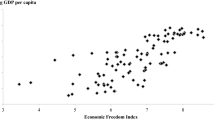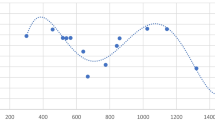Abstract
We study the effect of countries’ historical legacy with corruption on recent climate change policies and on global cooperation. Current policy outcomes build on policy choices made in previous years, and these choices were likely affected by the degree of corruption at the time. Our empirical findings using data for up to 131 countries suggest that accumulated historical experience with corruption is important for today’s policy outcomes, and appears to be more important than the current level of corruption.
Similar content being viewed by others
Notes
See Holmberg et al. (2009) for a survey of the effects of governance and corruption on environmental sustainability.
Results for this alternative operationalization of KP Commitment are available upon request.
In additional estimations (available upon request), we find that this difference in results is not due to the larger sample size using the WB measures. If we artificially restrict Models 3–4 to the samples used in Models 1–2, the Corruption-control measures based on the World Bank source continue to be statistically significant.
Table 2 Main regressions The main contribution of this paper is to propose a measure of corruption which takes historical experience into account (using existing corruption measures) in the determination of climate change policies. We leave it for future research to study the possible advantages of alternative corruption measures for this line of research.
One may be concerned that because Corruption-control capital is set to zero for all countries in the first year of each sample, we could under-estimate the effect of Corruption-control capital considering that the actual experience with corruption started at an earlier point in time. In an additional robustness test we explore whether this initial under-estimation threatens our inferences. We set the initial value of Corruption-control capital to the first available value of the Corruption-control level rather than to zero. Our results are fully robust.
References
Aichele R, Felbermayr G (2012) Kyoto and the carbon footprint of nations. J Environ Econ Manag 63:336–354
Anbarci N, Escaleras M, Register CA (2009) The Ill effects of public sector corruption in the water and sanitation sector. Land Econ 85(2):363–377
Barbier EB (2010) Corruption and the political economy of resource-based development: a comparison of Asia and Sub-Saharan Africa. Environ Resour Econ 46:511–537
Barbier EB, Markandya A (1990) The conditions for achieving environmentally sustainable development. Eur Econ Rev 34(2):659–669
Barbier EB, Damania R, Léonard D (2005) Corruption, trade and resource conversion. J Environ Econ Manag 50:276–299
Beck T, Clarke G, Groff A, Keefer P, Walsh P (2001) New tools in comparative political economy: the database of political institutions. World Bank Econ Rev 15:165–176
Besley T, Persson T (2011) Pillars of prosperity. Princeton University Press, Princeton
Biswas AK, Farzanegan MR, Thum M (2012) Pollution, shadow economy and corruption: theory and evidence. Ecol Econ 75:114–125
Bohn H, Deacon RT (2000) Ownership risk, investment, and the use of natural resources. Am Econ Rev 90:526–549
Burgess R, Hansen M, Olken BA, Potapov P, Sieber S (2012) The political economy if deforestation in the tropics. Q J Econ 127(4):1707–1754
Campante FR, Do Q-A (2010) A centered index of spatial concentration: expected influence approach and application to population and capital cities. Mimeo. Kennedy School, Harvard University
Coate S, Morris SE (1999) Policy persistence. Am Econ Rev 89:1327–1336
Cole MA (2007) Corruption, income and the environment: an empirical analysis. Ecol Econ 62:637–647
Damania R, Fredriksson PG, List JA (2003) Trade liberalization, theory and evidence. J Environ Econ Manag 46(3):490–512
Damania R, Fredriksson PG, Mani M (2004) The persistence of corruption and regulatory compliance failures. Public Choice 121(3–4):363–390
Donchev D, Ujhelyi G (2014) What do corruption indices measure? Econ Polit 26(2):309–331
Esty DC, Levy M, Srebotnjak T, de Sherbinin A (2005) 2005 Environmental sustainability index: benchmarking national environmental stewardship, New Haven: Yale Center for Environmental Law and Policy
Fredriksson PG, Neumayer E (2013) Democracy and climate change policies: is history important? Ecol Econ 95:11–19
Fredriksson PG, Svensson J (2003) Political instability, environmental policy. J Public Econ 87:1383–1405
Fredriksson PG, Wollscheid JR (2014) Political institutions, political careers and environmental policy. Kyklos 67(1):54–67
Fredriksson PG, Vollebergh HRJ, Dijkgraaf E (2004) Corruption and energy efficiency in OECD countries: theory and evidence. J Environ Econ Manag 47(2):207–231
Fredriksson PG, Neumayer E, Ujhelyi G (2007) Kyoto protocol cooperation: does government corruption facilitate environmental lobbying? Public Choice 133:231–251
Holmberg S, Rothstein B, Nasiritousi N (2009) Quality of government: what you get. Annu Rev Polit Sci 12:135–161
Ivanova K (2011) Corruption and air pollution in Europe. Oxf Econ Pap 63:49–70
Kaufmann D, Kray A, Mastruzzi M (2009) Governance matters VIII: aggregate and individual governance indicators, 1996–2008. World Bank Policy Research working paper no. 4978
Knack S (2007) Measuring corruption: a critique of indicators in Eastern Europe and Central Asia. J Public Policy 27(3):245–291
Ko K, Samajdar A (2010) Evaluation of international corruption indexes: should we believe them or not? Soc Sci J 47:508–540
La Porta R, Lopez-de-Silanes F, Shleifer A, Vishny R (1999) The quality of government. J Law Econ Organ 15:222–279
Leitão A (2010) Corruption and the environmental Kuznets curve: empirical evidence for sulfur. Ecol Econ 69:2191–2201
List JA, Sturm D (2006) How elections matter: theory and evidence from environmental policy. Q J Econ 121(4):1249–1281
López R, Mitra S (2000) Corruption, pollution and the Kuznets environment curve. J Environ Econ Manag 40(2):137–150
Marshall MG, Jaggers K (2007) Polity IV project: dataset users’ manual. George Mason University and Center for Systemic Peace. www.systemicpeace.org/inscr/p4manualv2006.pdf
Mungiu-Pippidi A (2006) Corruption: diagnose and treatment. J Democr 17(3):86–99
Neumayer E (2002) Does trade openness promote multilateral environmental cooperation? World Econ 25:815–832
Oliva P (2014) Environmental regulations and corruption: automobile emissions in Mexico City. J Polit Econ (forthcoming)
Pellegrini L, Gerlagh R (2006) An empirical contribution to the debate on corruption, democracy and environmental policy. J Environ Dev 15(3):332–354
Persson T, Tabellini G (2009) Democratic capital: the nexus of political and economic change. Am Econ J Macroecon 1:88–126
Steves F, Treisman D, Teytelboyn A (2011) The political economy of climate change policy in the transition region. In: The low carbon transition, chap 4. EBRD and The Grantham Research Institute on Climate Change and the Environment, LSE
Welsch H (2004) Corruption, growth, and the environment: a cross-country analysis. Environ Dev Econ 9(5):663–693
Wheeler D (2011) Quantifying vulnerability to climate change: implications for adaptation assistance. Working paper 240. Center for Global Development
Wilson JK, Damania R (2005) Corruption, political competition and environmental policy. J Environ Econ Manag 49:516–535
World Bank (2012) World Development Indicators CD-Rom. World Bank, Washington DC
Author information
Authors and Affiliations
Corresponding author
Rights and permissions
About this article
Cite this article
Fredriksson, P.G., Neumayer, E. Corruption and Climate Change Policies: Do the Bad Old Days Matter?. Environ Resource Econ 63, 451–469 (2016). https://doi.org/10.1007/s10640-014-9869-6
Accepted:
Published:
Issue Date:
DOI: https://doi.org/10.1007/s10640-014-9869-6




